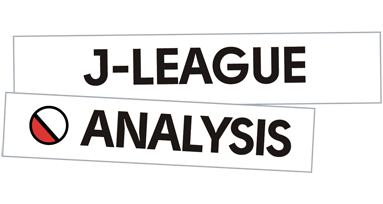Matchday 28 had come around last weekend in the J League as Yokohoma FC played host to the 2019 Japanese Cup winners, Vissel Kobe. History has shown this fixture to be a tight match up with no team particularly dominating. Both teams are looking to salvage something from their season with qualifying for the Asian Champions League seemingly very unlikely.
This tactical analysis will look at the tactics that both teams looked to employ as they altered their structures as the game progressed. This analysis will also highlight the critical role that key members of each team played during their sides attacking phases.
Lineups
Yokohoma set up in a 4-4-2 formation, focused on trying to bolster their defensive unit and letting the strike pair and wingers create the goal-scoring opportunities. Yuji Rokutan started off in goal with a back four of Takaaki Shichi, Masakazu Tashiro, Masahiko Inoha, and Mahuinhon providing protection. Kohel Tezuka and Tatsuki Seko were key players in midfield, whilst Katsuhiro Nakayama and Kosuke Saito held out on the flanks. That left Koki Saito and Kazunari Ichimi up front, although Saito would be the one to drop deeper into the midfield line to link play.
Conversely, Atsuhiro Miura’s Vissel Kobe lined up in a 4-1-4-1 formation. Starting between the sticks was Hiroki Ilkura with the centre-back pairing of Tetsushi Yamakawa and Hirofumi Watanabe protecting the 34-year old keeper. Both fullbacks, Daigo Nishi and Gotoku Sakai were able to push higher up and become more involved in the team’s attack. Hotaru Yamaguchi, Yuta Goke, and former Barcelona legend, Andrés Iniesta held down central areas and were able to control the pace of the team’s circulation of the ball. Daiju Sasaki and Keijiro Ogawa positioned themselves on the flanks, working with the fullbacks in partnership. Then it was Koriaki Fujimoto as the team’s lone striker up front.
Yokohoma in possession
Whilst set up as a 4-4-2 on paper, there were a few variations of their structure depending on the phase of play. In general possession, we would see a shift in the midfield which would enable Yokohoma to remain balanced and not get caught out in transition.
Being the more attacking-minded fullback, Maguinho (number three), would push higher so that Nakayama (27) was able to be more involved in link-play within the midfield. Number 30, Tezuka would then drop further towards the backline and act more as a holding midfielder so that if the ball was lost on the right flank, then he could slot in to create three at the back (four depending on the positioning of the opposite fullback, Shichi). The graph on the right shows Yokohoma’s attacks by flank and the danger level from those attacks. Although Yokohoma’s attack progressed further up on the right-hand flank, they were more dangerous on the left-hand side with 0.44 xG rating (expected chance of goal).
Above is an example of how Yokohoma looked to use Maguinho on the right-hand side to create goal-scoring opportunities. After shifting the ball to Nakayama on the right edge, the supporting midfielder, Seko moves across to support. As the ball is played from Nakayama to Seko, Maguinho continues his forward run and receives the ball in behind of the Vissel Kobe backline. Whilst Yokohoma remain comfortable in possession, Tezuka will remain higher up in the midfield zone until he anticipates when there is potential danger (such as losing the ball in wide areas when the fullback is caught high). Then he will start to drop into the backline so the ball side centre-back can push further out to where the fullback would be if he was defensively connected.
On the left-hand side, there were structural differences which emerged compared to the right-hand side. When Vissel Kobe felt like Yokohoma were comfortable in possession, they dropped back and formed their block. As a result, this gave Yokahoma’s two centre-backs more time and space on the ball. It would be Inoha who would be the more likely centre-back to drive forward if he saw space. However, he wouldn’t just run straight into the midfield zone. Inoha would angle his run with the ball toward the sideline where he had a number of options.
By driving on the angle, Inoha ensured that he had options left, right and high, thus creating a positional advantage. If the end product of this structure did not result in releasing a teammate behind the defensive line, then the player on the right-hand side of the diamond would be used as a linking player to find someone who could switch play. Be it by bouncing the ball back to the centre-back or turning out to find the supporting midfielder.
The role of Iniesta in Vissel Kobe’s attack
As seen over the past two years at Vissel Kobe, the La Liga superstar has been weaving his influence trying to impart the knowledge he has developed from his days in Barcelona. As such, the role he plays within the Vissel Kobe system is rather flexible when the team have possession. He can be seen to position himself more towards the left-hand side and in space so that he can manufacture a pass that either releases a player in behind the opposition defence, or one that recycles possession. Being a right-footed player on the left-hand side also means that the types of crosses he delivers travel from right to left, allowing teammates in the box to attack the ball with momentum, not against it. It also means that defenders need to get set earlier as they want to be clearing the ball against the right to left curvature, thus travelling away from goal. Conversely, if Iniesta drifted more centrally, he would play shorter ranged passes that look to find the highest player or get an advanced midfielder in between lines.
During phases of build-up, the Spanish playmaker will start by positioning himself off the shoulders of his closest marker. Within the first five minutes, he will drift around the field and gather information on who is going to stick tight to him and who will maintain a compact defensive structure. This information will be crucial to find out who he can drag out of position to create extra pockets of space. If they don’t follow him, then he will be able to receive the ball facing forward and find a more progressive pass.
Above we can see that Iniesta’s direct marker, Seko, is sticking tight to him and not allowing him to face forwards when the ball is received. However, by dragging his opponent higher up the field, it then creates the space for another teammate to drop into. If a higher positioned teammate was to receive the ball in that space, the timing of the run is important. If he ran too early, the marker would step up with him and close down the space that the player receives in. Too late and the distance between the teammate and his immediate marker would be too short to allow him to receive and turn comfortably.
To make sure that he would be able to effectively lose his marker to receive the ball in that space, the player would need to make two movements. The first movement is to fix the defender (usually by running away from the intended area), then the second movement is to break away and drop into the space. The player then creates the separation needed for him to be able to receive the ball facing forward.
The second scenario is when Iniesta is able to receive the ball facing forward. On the travel of the pass to Iniesta in between lines, this gives the signal for the highest players to break lines in behind the opposition defensive line.
The image above highlights this scenario. As Iniesta receives the ball from Watanabe, the right winger Ogawa starts to make his run in behind. Because of the explosiveness of the run, Ogawa’s defender then instinctively runs alongside with him to make sure he doesn’t go unchallenged. This is also an important piece of information because in the same future scenario, Iniesta could also find Nishi in space on the right flank or a supporting midfielder in the pocket vacated in front.
Vissel Kobe’s defensive reorganisation
Whilst Yokohoma were able to break Vissel Kobe’s immediate pressing scheme, Vissel Kobe were able to reorganise effectively to prevent being hurt on the counterattack. As we can see below, Yokohoma have effectively used quick play combinations to get their midfielder on the ball centrally so that he can switch play.
When Schichi (Yokohoma left fullback) gets the ball on the left-hand side, there will be nobody to be close enough to immediately affect and influence him. In this moment, the first priority is to get the back four connected so that they are able to slide across and protect the space they are leaving. When Schichi then gets the ball there is room for him to drive into so there is no point having Maguinho push that far out and get caught as the isolated defender. Vissel Kobe must allow Yokohoma receive the ball and drive forward into that space. As the ball gets switched across, the challenge for the group is to get as many bodies behind the ball as quickly as possible.
In the image above you can already see some of the midfielders just turning towards goal and dropping (not even dropping and sliding across.) Once Vissel Kobe gets back in an organised defensive unit, they can then slide across and meet the opposition at a point closer to goal.
Above is what transpired from the switch of play. The Yokohoma fullback drove all the way into Vissel Kobe’s half but has now lost their positional advantage. Both midfield and defensive lines are now connected and are marking supporting Yokohoma teammates. The danger here can sometimes be the lack of attentional focus given to the far side opposition players. Because players are focused on getting back quickly and connecting in their lines of four, it leaves the far side opposition players free (Nakayama in the instance above). Therefore, a team cannot afford to have their far side fullback and winger near the centre of the goal. They must continue to check their shoulder to see if they have changed their positioning or pose any threat off the switch of play.
Conclusion
With seconds remaining on the clock, feeling like they had momentum and could secure a win, Yokohoma flooded men forward as Vissel Kobe sat deeper. After receiving the ball at the top of the box, 19-year old substitute Reo Yasunaga netted home the winner, curling the ball into the near post. This sent the home crowd into a frenzy as Yokohoma celebrated the teenage midfielder’s first goal of the 2020 season.
Vissel Kobe have a three-day turnaround period as they are again on the road to play second placers, Gamba Osaka. Conversely, Yokohoma are also on the road and are set to play Sanfreece Hiroshima over the weekend.














